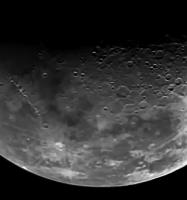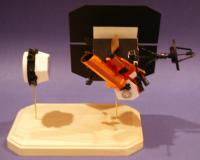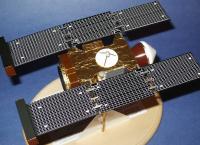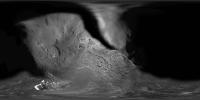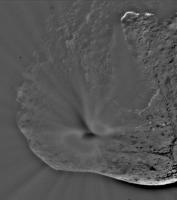Printable Version of Topic
Click here to view this topic in its original format
Unmanned Spaceflight.com _ Cometary and Asteroid Missions _ Stardust + Deep Impact mission extensions
Posted by: ynyralmaen Jul 4 2007, 10:36 AM
- Deep Impact to fly by Boethin on December 5, 2008.
- Stardust to visit Tempel 1 (DI's previous target) on February 14, 2011.
More details here:
http://stardust.jpl.nasa.gov/news/status/070703.html
Posted by: tedstryk Jul 4 2007, 12:02 PM
Yes!!!!!!!!!! Thanks for posting that. I am glad to see that they won't squander two good spacecraft. I wonder if the light curve/rotation period of Temple-1's nucleus is pegged well enough to ensure catching the crater. I doubt it, but it would be nice. Even still, it will be interesting to see it again. While the press release statement, "It will mark the first time a comet has ever been revisited," had me screaming HALLEY FLOTILLA!, this will be the longest period of time between visits to the same comet.
I am also glad to see Deep Impact being used again. Although HRI isn't great, the spacecraft has a lot of other great instruments, and even HRI's out of focus shots are better than anything we could get of a comet's nucleus from earth.
I wonder if they will try to free Stardust's filter wheel. I remember it was never attempted because it was stuck on a convenient filter, and they didn't want to risk getting stuck on something less desirable for the Wildt-2 encounter. However, with having to have NAVCAM for the sample return mission over, it sure would be neat to try to free it.
Posted by: ElkGroveDan Jul 4 2007, 04:22 PM
Brilliant on both counts. I'm really impressed.
Posted by: Paolo Jul 4 2007, 07:00 PM
This is a very good new, but it also makes me wonder: is this all for this round of Discovery missions? Do they only approved extensions and no new missions?
Posted by: Alan Stern Jul 4 2007, 07:10 PM
New mission proposals not yet fully evaluated. Decisions expected by early October.
-Alan
Posted by: Paolo Jul 4 2007, 07:17 PM
-Alan
Thanks! Nice to hear that
Posted by: edstrick Jul 5 2007, 04:13 AM
Note there is *no* mention of imaging the Deep Impact crater in the press release. It's clear they consider rotational synchronizing on the basis of available light curve etc data too "iffy" for it to be an objective. I think they're assuming that any illuminated sub-hemisphere Stardust will observe will be as geologically diverse and interesting as the one imaged. *IF* we're lucky to be able to retarget the impact hemisphere, we get to observe changes between the 2 encounters due to mass loss and whatever at and beyond perihelion.
Posted by: nprev Jul 5 2007, 06:13 AM
Starting to see a theme emerge here wrt Discovery missions...creative reuse/extension of available assets. I like it, and gonna blame it all on Alan! ![]()
Begs one question, though: will Discovery-class proposals be henceforth evaluated not only on their ability to satisfy primary science objectives, but also on their capability for reuse? Hopefully not, because that might impose a lot of cost/schedule/performance risk on the initial design effort that just doesn't need to be there for cost-capped missions... ![]() ...exploiting serendipity where you find it after the fact seems like a wiser strategy.
...exploiting serendipity where you find it after the fact seems like a wiser strategy.
Posted by: edstrick Jul 6 2007, 07:50 AM
"Starting to see a theme emerge here...."
Uh.. the first mission extension was Mariner 4. After the Mars flyby and data playback, Earth started to move out of the view of the fixed high-gain antenna. The spacecraft was left in as safe a mode as possible and the carrier signal monitored at sparse intervals when possible. When it came around from the far side of the sun into good communications geometry, an extended interplanetary fields-and-particles study mission was started.
They attempted to contact Mariner Venus 67 (Mariner 5) in what would have been it's extended mission, as the vehicles would have drifted into alignment on the same solar-wind sector, but they could not find it's signal. Ultimately, they found it, way off frequency and drifting in frequency, carrier wave only, amplitude variations indicating slow spacecraft roll, and TOTALLY unresponsive (as far as they could tell) to commands. So much for THAT extended mission... permanently vegetative state.
Mariner 4 finally ran out of attitude control gas, went into a slow roll, and it's transmitter was turned off.
Mariners 6 and 7 had limited extended missions, Mariner 9, all Vikings, Mariner 10 (venus/mercury), etc etc etc had extended missions, as did all responsive Surveyors and Lunar Orbiters.
Posted by: Alan Stern Jul 6 2007, 11:16 AM
Nprev-- Thx for the vote of confidence, but the credit you offer me is undeserved. Proposal teams
form the pool of ideas. From that these two Mission of Opportunity were selected for Phase A studies.
All of that took place before my watch began in April. What we did was, after assuring ourselves both of these proposals in study had no significant flaws, was to find the resources to fund both. We did not architect the ideas. We simply leaned forward in selecting both vis an either or situation, and I think as a result, we have both reinvigorated US comet science and added to our exo-planet detection efforts as well.
-Alan
Posted by: Littlebit Jul 6 2007, 02:01 PM
Even though it is not promised, it is time to reopen the pool on the depth and diameter of Tempel 1's crater. (providing the very ticked-off aliens don't shoot first this time...)
Posted by: Oren Iishi Jul 21 2007, 04:06 PM
I am also glad to see Deep Impact being used again. Although HRI isn't great, the spacecraft has a lot of other great instruments, and even HRI's out of focus shots are better than anything we could get of a comet's nucleus from earth.
I wonder if they will try to free Stardust's filter wheel. I remember it was never attempted because it was stuck on a convenient filter, and they didn't want to risk getting stuck on something less desirable for the Wildt-2 encounter. However, with having to have NAVCAM for the sample return mission over, it sure would be neat to try to free it.
I would also like NASA to make an attempt to correct the filter wheel issue. My guess is that it might be too risky. I was also wondering what additional information could be obtained if they were able to fix the problem.
Posted by: edstrick Jul 22 2007, 07:51 AM
Part of the problem is that COLOR imaging at comets is really marginal. Deep Impact did see subtle color variations related to exposures of sublimating water that were seen by the infrared spectrometer, but comet nucleii are nearly featureless as far as regular color imaging goes. You have to have high signal to noise ratio images taken with widely spaced (in wavelength) color filters for maximum spectral separation, or a true middle infrared camera, equivalent to the CRISM on Mars Recon Orbiter or the imaging infrared spectrometer on Cassini, before you can see much of anything.
Posted by: tedstryk Jul 22 2007, 06:04 PM
The filters were well selected, such as the NH2 Emission filter and Oxygen Emission filter. The results would have been scientifically interesting.
Posted by: edstrick Jul 23 2007, 06:47 AM
Those would image coma chemical structures. Very interesing and important, but I'm thinking more in terms of nuclear "geology"
Posted by: NMRguy Nov 21 2007, 11:53 PM
We have a couple of updates for our two Missions of Opportunity. In order to get Stardust and Deep Impact to their respective next destinations (EDIT: Tempel 1 and 85P/Boethin), we need to have targeted gravity assists from Earth. Deep Impact (EPOXI) will swing by Earth this December 31, 2007 to set up its encounter with Boethin on December 5, 2008. Does anyone know if the extended mission funding allows for any imaging during the flyby, even if just for outreach?
Also, Stardust-NExT just completed a successful deep space maneuver, setting up its own gravity assist with Earth in January 2009. The eventual flyby of Tempel 1 is scheduled for February 14, 2011.
http://stardust.jpl.nasa.gov/news/status/071010.html
"Stardust successfully performed Deep Space Maneuver 1. This was the first maneuver without the Sample Return Capsule where an accurate burn performance was required. This maneuver will place the spacecraft on a trajectory to perform an Earth Gravity Assist in January 2009."
Posted by: IM4 Nov 23 2007, 02:04 PM
Bad news everyone!
New Target
In the first half of October, Karen Meech organized an heroic effort to recover comet Boethin in time to plan the spacecraft's flyby of Earth, which would put it on target to go to the comet. The orbit is very uncertain due to the comet having been observed at only two apparitions, with no observations since 1986, and the uncertainty is so large that we would not have enough fuel on board to compensate for the uncertainty in the orbit after the flyby of Earth. This effort was not successful.
As a result, I recommended to NASA that we switch to our backup target, comet 103P/Hartley 2, which has a very well defined orbit but which requires two extra years for the mission and thus additional funding from NASA. The encounter for the backup plan is on 11 October 2010.
NASA authorized us to plan and execute the Earth flyby as though we were going to comet Hartley 2, while they consider whether they can afford to pay for the longer mission. The maneuver to set up the flyby of Earth was executed on 1 November and appears to have been flawless. The flyby of Earth will occur on New Year's Eve, 31 December 2007.
http://epoxi.umd.edu
Posted by: NMRguy Nov 28 2007, 02:48 PM
Am I correct to assume that the "Extrasolar Planet Observation and Characterization" (EPOCh) portion of EPOXI using the unfocused High Resolution Imager to search for extrasolar planets is still to be funded, regardless of Alan's decision whether to continue funding for "Deep Impact Extended Investigation" (DIXI) with the change in primary target from Boethin to Hartley 2? EPOCh was to commence directly after the flyby from January to May 2008.
Also, some calibration measurements were planned for the http://epoxi.umd.edu/1mission/index.shtml. "The HRI, High Resolution Instrument, including its infrared spectrometer, and the MRI, Medium Resolution Instrument are recalibrated using our Moon as a target. On the last day of 2007, the spacecraft achieves its closest approach to Earth - the altitude is a mere 19,310 km above eastern Asia."
Posted by: belleraphon1 Nov 28 2007, 04:54 PM
Well, "looks like the Boethin has rooked us again"!
Craig
Posted by: NMRguy Dec 15 2007, 10:44 PM
Two bits of information on Deep Impact EPOXI.
- As you may already know, NASA Headquarters approved funding for Deep Impact to target Hartley 2 instead of Boethin. The first of three gravity assists will be the end of this month.
- EPOCh is still moving forward and has already begun taking some calibration measurements.
http://epoxi.umd.edu/1mission/status.shtml
Posted by: mps Dec 31 2007, 10:10 AM
Some recent Moon images and Earth flyby description are up on EPOXI http://epoxi.umd.edu/
Posted by: tedstryk Dec 31 2007, 03:35 PM
Here is my version of the release image. I look forward to the release of HRI images that are not deconvolved. I was really limited in what I could do because of the fact that I was processing a processed image. It is interesting to note that MRI's resolution doesn't appear too much worse than the out of focus HRI. I hope that during the comet encounter they get close enough to get some good multispectral data with MRI.
Posted by: IM4 Feb 29 2008, 04:01 PM
Bad news again. http://epoxi.umd.edu/, EPOCh observations interrupted.
Posted by: centsworth_II Feb 29 2008, 04:08 PM
Doesn't sound that bad to me:
"...the scientific output will not be compromised because additional observations
can be carried out after the previously scheduled end of operations for EPOCh.
Therefore, there has been no rush to bring the spacecraft out of safe mode..."
Posted by: Paolo Nov 30 2008, 07:27 PM
Interesting article about the missed recovery of comet Boethin the original target of Deep Impact's mission extension
http://transientsky.wordpress.com/2008/11/10/where-o-where-has-comet-boethin-gone-the-case-of-the-missing-comet/
Posted by: mps Dec 11 2008, 09:19 AM
There are two backpackers out there, soon visiting briefly their home. Deep Impact will fly by Earth on December 30, Stardust on January 14.
I can't find out anywhere, if there is any imaging planned during the flybys - so I wonder if anybody here is better informed about that?
A hint for Santa - there is a Earth approach movie in my wish list ![]()
Posted by: NGC3314 Dec 12 2008, 04:28 PM
I can't find out anywhere, if there is any imaging planned during the flybys - so I wonder if anybody here is better informed about that?
A hint for Santa - there is a Earth approach movie in my wish list
Checking the ephemeris on JPL Horizons, the approach is from the night side over high southern latitudes. For ground based observers who want to try imaging the spacecraft, the best view near closest approach is from the southern hemisphere (probably Australia for longitude). In North America, the hours just after midnight on Dec. 29 look best (as it moves rapidly south of Orion), although the range is still 210,000 km at best. I got a detection last year with a 0.9m telescope by tracking on the expected motion, and as I look back, the range this time will be more favorable. Hmm - I don't have the 0.9m that night, but our campus 0.4m is open...
Posted by: robspace54 Dec 15 2008, 03:30 PM
Deep Impact will fly by Earth on December 30 and Stardust on January 14? Sweet!
December 30 is my birthday! Three years ago I built a scratch-built model of Deep Impact and the Impactor (slightly out of focus photo here). I also built a Stardust two years ago, also shown. Both models in 1/24 scale.
Rob
Posted by: Stu Dec 15 2008, 03:36 PM
Nice work, Rob! ![]()
Posted by: mps Dec 23 2008, 11:24 AM
Sorry, this information (source: http://epoxi.umd.edu/4gallery/graphics/EPOXI_Mission_H2_Timeline-lg.jpg) is outdated, it seems that DI will fly by Earth on December 29 (http://www.nasa.gov/mission_pages/epoxi/index.html).
Posted by: Paolo Dec 27 2008, 09:00 PM
While waiting for news of Deep Impact's Earth flyby, did anybody else notice the CONTOUR-like http://www.nasa.gov/mission_pages/epoxi/trajectory.html?
I am looking for more informations but I am finding none...
Posted by: Paolo Dec 28 2008, 10:05 AM
A few details http://epoxi.umd.edu/4gallery/EPOXI_Mission_Trajectoryc.shtml
Posted by: akuo Dec 28 2008, 11:37 AM
Are there any information about flyby visibility from Earth? I assume EPOXI will be very faint, but probably still possible to image with a telescope.
Posted by: akuo Dec 28 2008, 01:46 PM
Answering to my own query, I got the following information from the SeeSat mailing list:
beforehand here in Australia. The departure is on daylight side of Earth so
not of any interest. I dont expect it will get brighter than mag 15 .
Posted by: IM4 Dec 28 2008, 09:13 PM
HORIZONS predicts EPOXI flyby as follows:
---------------------- ----- -------- ------
A.D. 2008 Dec 29.90349 Earth 0.000333 5.289
A.D. 2008 Dec 30.08001 Moon 0.002322 4.697
43500 km above Pacific - most distant Earth flyby I've ever seen.
Posted by: Paolo Dec 28 2008, 09:19 PM
The flyby does not appear to be necessarily close. It will only need to boost the orbit eccentricity, while the semiaxis will remain fixed at 1 AU. There is one more flyby coming in just one year in late December 2009
Posted by: NGC3314 Dec 30 2008, 05:53 AM
I seem to have not detected it with a 0.9m telescope in Arizona early on the 28th UT. The same setup did see it last time, but I haven't had a chance to dig into the new images very carefully.
Posted by: mps Dec 30 2008, 08:00 AM
Flyby distance was a tiny bit closer than that - "within 43000 km" (http://www.nasa.gov/mission_pages/epoxi/index.html
Posted by: dmuller Jan 4 2009, 06:03 PM
At last I have put a preliminary version of the EPOXI realtime simulation online: http://www.dmuller.net/epoxi
As usual, please report any bugs and further mission information you may have :-)
Incidentally I noticed a "close-ish" Earth flyby on 29 Jun 2009 around 8am UTC, distance 1.3 million km
Posted by: Paolo Jan 4 2009, 06:09 PM
This is due to the one-year orbit of EPOXI
Posted by: Phil Stooke Jan 14 2009, 12:18 AM
Here are some images of the moon taken by Stardust:
http://stardustnext.jpl.nasa.gov/multimedia/ega_images.html
And more information:
http://stardustnext.jpl.nasa.gov/mission/ega.html
Phil
Posted by: ElkGroveDan Jan 14 2009, 12:52 AM
Which moon? Titan?
Posted by: Phil Stooke Jan 14 2009, 01:33 AM
Oops, I should have said The Moon.
Phil
Posted by: ElkGroveDan Jan 14 2009, 05:26 AM
The hazy appearance had me confused. ![]()
Posted by: dmuller Jan 14 2009, 07:22 AM
I somehow seem to have missed these two mission extensions completely. My apologies. Very preliminary Stardust realtime simulation page now at http://www.dmuller.net/stardust - I hope I have trajectory data in there within 48 hours.
Posted by: NGC3314 Jan 14 2009, 03:36 PM
Here is a set of images of Stardust/NExT nearing the Earth swingby, from our campus observatory 0.4m telescope. They are 4-minute exposures tracking the expected motion from the JPL Horizons ephemeris, from 0451-0539 UT on Jan 14. At a range of about 350,000 km, it was roughly 16th magnitude.
Posted by: Zvezdichko Aug 18 2009, 09:54 AM
http://www.nasa.gov/mission_pages/stardust/news/stardust_amino_acid.html
How could somebody miss that?
Amino acid found on a comet!
Posted by: djellison Aug 18 2009, 10:00 AM
Aug 11, 2003
http://physicsworld.com/cws/article/news/18059
Courtesy of Nick posting at THZ.
Posted by: Zvezdichko Aug 18 2009, 10:06 AM
Yes, it's indeed the simplest of all amino acids. We have two H- ligands attached to the C-atom - it's not a chiral centre. We can't talk about L- and D- types of glycine.
I will be interested to see more amino acids found on comets and asteroids - and to see if L- or D- prevail.
Posted by: djellison Aug 18 2009, 10:18 AM
The date was the important thing. This isn't a revelation - Glycerine in space was found 5 years ago.
Posted by: Zvezdichko Aug 18 2009, 10:48 AM
Oh, yes, I see your point. Not actually new, probably.
But let me correct you - it's glycine, not glycerine. Glycine is the amino acid. Glycerine is an alcohol with three -OH groups and forms esters with fatty acids - the result is fats.
glycine forms polypeptides and proteins.
Posted by: marsbug Aug 18 2009, 11:05 AM
It's not world changing but it's still a first for comet studies, and exploring whether the glycine was inherited from the solar nebular or generated on the comet should be interesting.
Posted by: Paolo Nov 3 2009, 06:35 AM
Stardust in safe mode over the last weekend
http://stardustnext.jpl.nasa.gov/mission/mission_status09_q4.html
At the start of Thursday’s DSN pass Stardust-NExT was acquired in safe mode. Analysis of the recorded data showed the spacecraft entered safe mode late Monday evening.The Attitude Knowledge Performance Monitor requested safe mode because the Star Camera failed to respond to commands issued by the processor. Also impacted were the CIDA instrument and the Sun Sensor. Both of these components were not able to communicate with the processor. The Sun Sensor returned to nominal operations during the safe mode execution and the Star Camera returned to nominal after it was power cycled as part of the response by the Safe Mode Executive. CIDA will be returned to nominal operations during our DSN pass on Monday, November 2. This safe mode was nearly identical to the Oct 2003 safe mode event. That entry was caused by a solar flare that caused communications problems with the Star Camera, Sun Sensor, CIDA and Navigation Camera. Interestingly, that same day in October 2003, the Genesis and Odyssey spacecrafts also entered safe mode due to the same solar flare. The investigation into the cause of the current event is continuing. The spacecraft team successfully exited safe mode during Saturday’s afternoon pass and returned spacecraft operations to normal.
Posted by: Sunspot Nov 3 2009, 08:46 AM
I wonder if all these safe mode events have anything to do with the deepest solar minimum in a century and the associated large increases in Cosmic Rays??
Posted by: Paolo Feb 14 2010, 10:07 AM
Stardust will perform the Tempel 1 targeting maneuver next 17 February. I think the correction takes into account the latest determinations of the spin period of the nucleus in order to catch the crater dug by Deep Impact during the flyby.
http://stardustnext.jpl.nasa.gov/mission/mission_status10_q1.html
Posted by: Explorer1 Feb 14 2010, 08:54 PM
On a related note, is there some archive somewhere of NASA TV's control room footage from impact day? I've looked on both the NASA and Deep Impact sites and haven't found anything. I remember them putting that first picture of the impact up live, and all the cheering, and would like to relieve the moment!
Posted by: tedstryk Feb 15 2010, 11:51 AM
I think they were "relieved" when they knew the impactor hit.
Posted by: Explorer1 Feb 16 2010, 11:38 PM
Oops, I meant 'relive'.
Anyone know if those moments are saved anywhere? Since some documentaries have used control room footage from the MER landing and Cassini orbit insertion, I know they exist too. Are they publicly available?
Posted by: djellison Feb 17 2010, 12:10 AM
http://www.jpl.nasa.gov/videos/vidcat.pdf
It there was video online, google would almost certainly find it.
Posted by: Explorer1 Feb 17 2010, 04:57 AM
It there was video online, google would almost certainly find it.
Thanks for the link.
Posted by: dmuller Feb 17 2010, 05:29 AM
You can also try http://www.space-multimedia.nl.eu.org/ ... if it was on NASA TV then it should be there (right now though the site seems to be down)
Posted by: Paolo Feb 18 2010, 07:32 PM
Tempel targeting burn successful
http://www.jpl.nasa.gov/news/news.cfm?release=2010-055&cid=release_2010-055&msource=20100218&tr=y&auid=5956241
Posted by: Explorer1 Feb 18 2010, 09:24 PM
Looks more and more likely that the Crater Contest will finally have a belated winner.
http://www.planetary.org/explore/topics/comet_crater/
Good luck Stardust team!
Posted by: elakdawalla Feb 18 2010, 09:27 PM
Gosh, thanks for the reminder on that, Explorer1. It had totally wandered off my radar screen. Wonder if we still have that entrant database lying around anywhere...
Posted by: Explorer1 Feb 19 2010, 02:29 AM
Are there still prizes left after the 3 randomly selected winners? I regret not participating when I had the chance...
Only a year to go!
Posted by: elakdawalla Feb 19 2010, 02:39 AM
No, we gave out the prizes, it wouldn't have been the right thing to do to declare no winner. But I know a lot of people were dissatisfied with the resolution of the contest (not the least of whom, I'd say, were the scientists), so there's going to be a lot of public interest in what Stardust sees.
What they expect to see is nicely summarized http://stardustnext.jpl.nasa.gov/mission/pdfs/SD_NEXT_Fctsht.pdf.
Posted by: Explorer1 Feb 19 2010, 08:13 AM
It's pretty incredible that we can predict what part of an object is sunlit years after it was seen close up. As long as as Tempel hasn't changed much in the intervening years...
Posted by: Phil Stooke May 30 2010, 11:30 PM
Here's a little cartographic experiment I've been playing around with. This is a preliminary version of a map of the nucleus of Comet Tempel-1 using Deep Impact images. The main part of the map is based on the image mosaic available on the Deep Impact site, reprojected by using a version of the image with a lat-long grid which is also on their site. Zero longitude is in the middle.
But unlike the version of this map published in a paper in Icarus by Peter Thomas and colleagues, I have extended this with the image of the departing view of the nucleus - that's the sliver running up to the north pole. Its position is only approximate. The Icarus version of the map had an extension around the south pole as well, but it was not very nicely dealt with. Here I have improved the representation of that area by going back to the raw data. This is an area beyond the nominal terminator which was illuminated by sunlight reflected off the impact plume itself, showing up beautifully in the Medium res images.
I will be doing all this again with better processing and more images next year some time.
Phil
Posted by: Phil Stooke May 30 2010, 11:34 PM
... and here is one of those images of the south polar area, high pass filtered. The impact plume itself hides part of the nucleus. The limb of the nucleus is faintly visible on the dark side. Image number is in the file name if you save it.
Phil
Powered by Invision Power Board (http://www.invisionboard.com)
© Invision Power Services (http://www.invisionpower.com)

